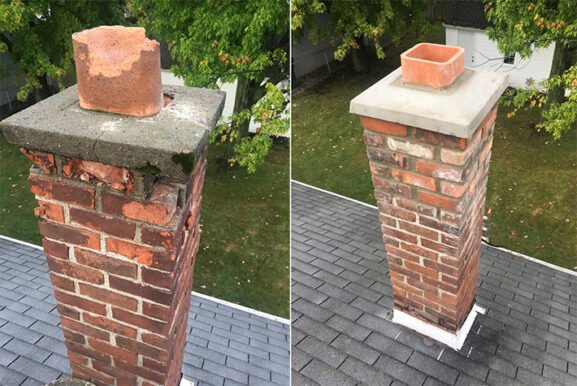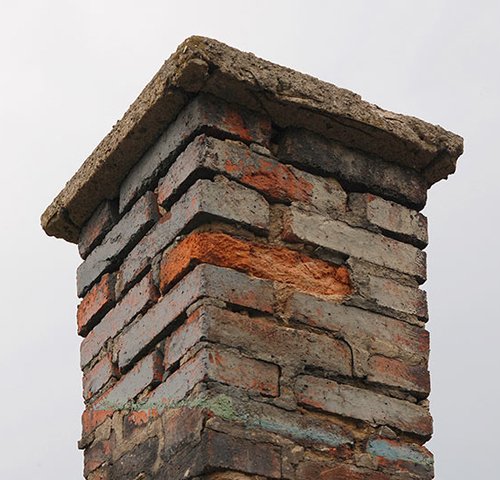How to Repair Chimney Crown the Right Way Before Costly Damage Occurs
Key Takeaways
- A damaged chimney crown can lead to serious water damage if not repaired promptly
- Effective repairs depend on identifying the type and extent of the crown damage
- Using the right materials like waterproof sealants or mortar is critical for durability
- In severe cases, partial or full crown reconstruction may be necessary to protect your chimney
Understanding What the Chimney Crown Does
The chimney crown is the sloped cement surface at the very top of your chimney. It plays a critical role in protecting the masonry beneath it from water penetration. Crowns are often confused with chimney caps, but they serve a very different function. While a cap keeps debris and animals out, the crown sheds rainwater and keeps moisture from seeping into the brickwork and flue.
Over time, exposure to weather — especially freezing and thawing cycles — can cause the crown to crack or deteriorate. When that happens, water can leak into the chimney structure, leading to mold, damaged bricks, rusted liners, or even structural instability.
Spotting the Signs of Chimney Crown Damage
Cracks in the crown are the most visible sign of trouble, but they’re not the only ones. You might notice water stains on the walls or ceilings near the chimney. In some cases, pieces of cement may break off and fall into the fireplace. Efflorescence — a white, chalky substance on chimney bricks — can also indicate that moisture is infiltrating the structure.
Inspecting the chimney from the ground can reveal major issues, but for a proper assessment, a technician should look at the crown up close. Binoculars or a drone inspection can be helpful tools if you’re trying to get a clearer view without climbing up yourself.
Determining the Right Repair Approach
Chimney crown repair isn’t a one-size-fits-all solution. The right method depends on the condition of the crown and the materials used in the original build. There are three common repair options used by professionals:
1. Crown Sealing for Minor Cracks
If the crown has hairline cracks but is otherwise intact, a professional-grade waterproof sealant is often enough to extend its life. These sealants are designed to remain flexible as the structure expands and contracts due to weather changes. Products like CrownCoat or flexible polyurethane sealers can be applied directly over the cleaned surface to seal out moisture.
The key is thorough surface preparation. Any debris, moss, or dust must be cleaned off, and the area needs to be dry before application. When applied properly, these coatings can last up to 10 years, according to the Chimney Safety Institute of America (CSIA) source.
2. Mortar Patching for Moderate Damage
When cracks are larger but the crown still has some structural integrity, patching with a high-quality mortar mix can be a solid choice. This involves chiseling out the damaged areas, applying a bonding agent, and then filling them in with new mortar. In some cases, masons use a fiber-reinforced mix to help prevent future cracking.
Mortar repairs must be made during dry weather and when the temperature is above 40°F to ensure proper curing. This type of repair offers a longer-term fix than sealing alone, especially when followed by a crown sealant on top for added protection.
3. Rebuilding the Chimney Crown
When the crown has crumbled, is severely cracked, or was poorly constructed to begin with, replacement is the safest and most durable option. This involves removing the old crown entirely and pouring a new one, usually with a concrete mix designed to withstand extreme weather conditions.
A properly rebuilt chimney crown should be at least 2 inches thick at the thinnest point and should extend beyond the chimney edge to form a drip edge. This drip edge helps divert rainwater away from the vertical brickwork, preventing future erosion or staining.
Rebuilding may also include reworking the flue tile to ensure it is properly spaced and vented, which helps maintain air flow and fire safety standards.
Why Material Choice Matters for Long-Term Success
Using the wrong materials is a common cause of chimney crown failure. For example, some crowns are made with simple mortar instead of poured concrete. Mortar is more porous and prone to cracking, especially in colder climates.
For professional-grade repairs, masons often choose a pre-cast concrete slab or custom-built poured crown using a mix that includes air-entraining agents. These agents help the concrete resist freeze-thaw cycles. A sloped surface is also critical to prevent water pooling, which can lead to premature wear.
When choosing sealants, it’s important to select products that are UV-resistant and flexible. A rigid sealant may crack within a season, undoing the repair work.
Preventive Measures to Extend Crown Life
Even after a repair, maintenance is important. Regular inspections can catch early signs of deterioration before they escalate. Experts recommend having the chimney crown inspected at least once a year, especially before and after the winter season.
Installing a chimney cap is another effective step. While it doesn’t replace the function of the crown, it shields it from direct rainfall, ice buildup, and nesting animals. Stainless steel or copper caps are often preferred for their durability and resistance to rust.
Additionally, applying a water-repellent treatment to the chimney’s brickwork can help reduce moisture absorption, which adds another layer of defense to the entire system.
When to Involve a Chimney Professional
There’s a limit to how much DIY work a homeowner should attempt. While minor sealing jobs might be within reach for experienced DIYers, structural cracks or full rebuilds are best handled by certified chimney professionals. Working at heights involves safety risks, and improper repairs can lead to bigger issues down the road.
A certified technician will also check related components like flashing, masonry joints, and the flue liner to make sure the chimney is functioning safely and efficiently. If your chimney is actively leaking or showing signs of structural instability, a professional evaluation should be your next step.
Final Thoughts on Keeping Your Chimney Crown in Top Shape
Repairing a chimney crown isn’t just about fixing cracks — it’s about preserving the integrity of your entire chimney system. Water infiltration can quietly destroy the structure from the inside out, so addressing crown damage promptly is key. By choosing the right repair method and materials, and by staying on top of annual inspections, homeowners can avoid expensive masonry repairs and keep their chimneys performing safely for years to come.

